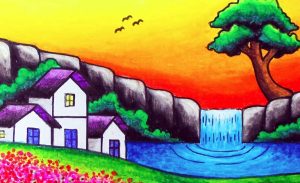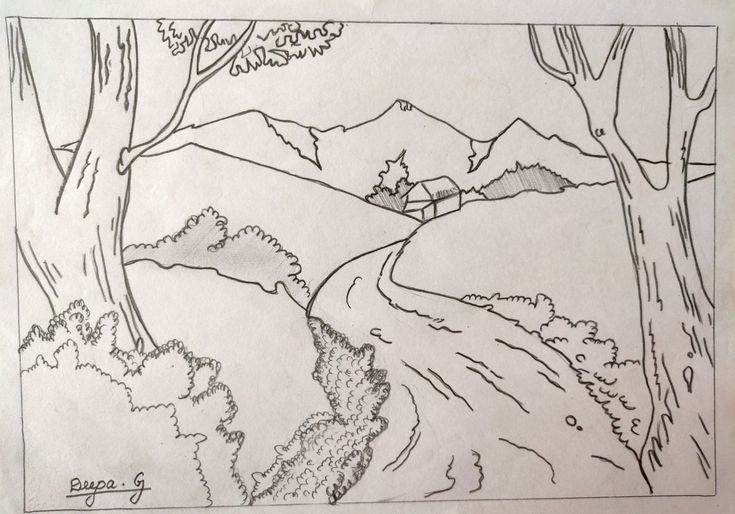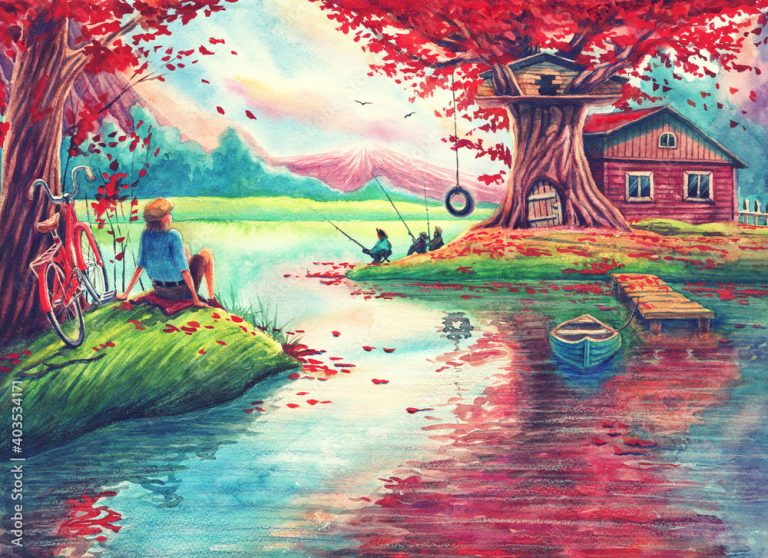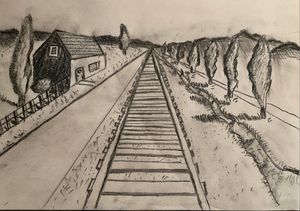Embarking on a nature drawing is like taking a tranquil journey through the great outdoors with pen and paper as your guides. Whether you choose to capture the serene beauty of a landscape, the delicate intricacies of a flower, or the graceful movement of a bird in flight, nature provides an endless source of inspiration. Begin by immersing yourself in the scene, observing the play of light and shadow

A Guide to Nature Drawing
Nature Drawing beauty surrounds us, from delicate flower petals to towering redwoods. Capturing its essence on paper can be a deeply rewarding experience, connecting you to the natural world and honing your artistic skills. Whether you’re a seasoned artist or just starting out, here’s your guide to drawing nature:
Gear Up:
- Notebook or Sketchpad: Choose a portable option for on-the-go drawing. Spiral-bound notebooks or loose sheets in a clipboard provide flexibility.
- Pencils: A variety of H (hard) and B (soft) pencils allows for different tones and textures. Start with an HB as your all-rounder.
- Erasers: A kneaded eraser for gentle corrections and a vinyl eraser for bolder removals are handy companions.
- Sharpeners: Keep your pencils at their peak with a good metal sharpener.
- Extra Supplies: Colored pencils, crayons, or ink pens can add a dash of color, while a small travel easel can provide support in the field.
Finding Inspiration:
- Step Outside: The best inspiration is often right outside your door. Start with familiar parks, your backyard, or even a windowsill with potted plants.
- Seasonal Delights: Observe how nature changes throughout the year. Capture spring’s blooming flowers, summer’s lush greenery, autumn’s vibrant leaves, and winter’s stark beauty.
- Focus on Details: Don’t try to draw the whole scene at once. Zoom in on interesting textures, delicate patterns on leaves, or the intricate veins of a butterfly’s wing.
- Wildlife Encounters: Watch birds flitting among branches, squirrels scampering on trees, or butterflies fluttering in a meadow. Capturing their movement can be a fun challenge.
Drawing Techniques:
- Contour Lines: Start by outlining the basic shapes of your subject using light, continuous lines. Don’t worry about perfection—focus on capturing the overall form.
- Negative Space: Pay attention to the spaces between objects, like the spaces between leaves or the silhouette of a bird against the sky. This helps define their shapes and adds depth.

Exploring Nature through Art
Nature Drawing, in all its diversity and wonder, begs to be explored, and what better way than through the magic of art? Here are some ideas to spark your creativity and bring the great outdoors indoors:
Visual Delights:
- Paint the Panorama: Capture the breathtaking sweep of a landscape. Imagine rolling hills ablaze with fall foliage, a serene lake reflecting the sky, or a rugged coastline basking in a golden sunset.
- Zoom in on Details: Don’t get lost in the grandeur. Focus on a microscopic world teeming with life – delicate spiderwebs shimmering with dew, intricate patterns on a butterfly’s wing, or the vibrant veins of a leaf.
- Embrace Abstraction: Let nature inspire your inner abstract expressionist. Imagine a forest transformed into a vibrant tapestry of greens and browns, or crashing waves translated into dynamic lines and textured washes.
Sculptural Explorations:
- Transform Found Objects: Give driftwood a second life as a graceful bird, smooth stones into playful animal figurines, or fallen leaves into a mosaic depicting a forest floor.
- Clay Creations: Mold clay into lifelike creatures, whimsical plants, or abstract representations of natural forces like wind or water. Let your hands become the tools of your artistic journey.
- Mixed Media Magic: Combine found objects, wood, metal, and natural materials like feathers or shells to create unique sculptures that celebrate the interconnectedness of the natural world.
Performance and Participation:
- Dance of the Elements: Choreograph a performance that mimics the flow of a river, the swaying of trees in the wind, or the playful movements of animals. Let your body language speak the language of nature.
- Sounds of the Wild: Compose a musical piece that captures the symphony of nature – birdsong, rustling leaves, gurgling streams. Use traditional instruments or found objects to create an immersive sonic experience.

Drawing the Colors of the Outdoors
Capturing the vibrant palette of the outdoors in your drawings can be a truly magical experience. Here are some ideas to ignite your creativity and translate nature’s beauty onto paper:
Observing the Spectrum:
- Light and Shadow Play: Notice how sunlight dances across landscapes, creating contrasting areas of warm and cool hues. Use this interplay to add depth and dimension to your drawings.
- Seasonal Shifts: Each season boasts its own unique color palette. Capture the fiery oranges and reds of autumn foliage, the soft pastel greens of spring meadows, the vibrant blues and yellows of summer skies, or the stark beauty of winter’s monochrome scenes.
- Micro and Macro Views: Zoom in on the intricate color variations in a single flower petal or step back to encompass the vast expanse of a sunset-hued desert. Both perspectives offer unique color harmonies to explore.
Bringing Colors to Life:
- Experiment with Mediums: Explore different drawing materials beyond traditional pencils. Colored pencils, crayons, pastels, and even inks can bring nature’s vibrancy to life in diverse ways.
- Layering and Blending: Create depth and complexity in your drawings by layering and blending different colors. Experiment with wet-on-wet techniques for soft transitions or sharp lines for defined contrasts.
- Unexpected Color Palettes: Don’t be afraid to step outside the box! Try using complementary colors to create eye-catching contrasts, or explore muted tones for a more subtle and atmospheric effect.
Capturing the Essence:
- Mood and Emotions: Use colors to evoke specific feelings. Cool blues and greens can convey tranquility, while warm oranges and yellows might suggest energy and excitement. Think about the mood you want to create and choose your colors accordingly.

A Journey into Nature Drawing
Nature whispers stories in rustling leaves, sings in gurgling streams, and dances in swaying branches. Let’s embark on an artistic adventure, capturing its essence through drawing. This journey holds countless paths, and here are some to guide you:
Unfolding the Landscape:
- Sunrise Symphony: Bathe in the golden glow of dawn, drawing a silhouette of mountains bathed in light, a lake reflecting the fiery sky, or a lone bird heralding the new day.
- Emerald Forest Depths: Venture into the verdant embrace of a forest. Capture the intricate patterns of sunlight filtering through leaves, the gnarled roots of ancient trees, or a playful deer peeking from behind foliage.
- Windswept Coastline: Feel the ocean’s spray on your face as you draw rugged cliffs pounded by waves, seagulls soaring against a stormy sky, or the intricate patterns of sand sculpted by the wind.
Zooming into Details:
- Butterfly’s Symphony: Trace the delicate veins on a butterfly’s wing, its vibrant colors a kaleidoscope of nature’s artistry. Explore the intricacies of its form, capturing its beauty in intricate lines.
- Spider’s Web Wonder: Gaze in awe at the intricate architecture of a spider’s web, glistening with dewdrops like tiny diamonds. Let your lines become strands of silk, capturing the delicate interplay of light and shadow.
- Pebble Whispers: Hold a smooth pebble in your palm, feel its textures, and draw the story etched within. Let its worn surface whisper of ancient rivers and crashing waves, each line a testament to time’s passage.
Experimenting with Techniques:
- Charcoal Whispers: Embrace the rawness of charcoal, creating bold strokes and smudged textures to depict a towering redwood’s bark, a roaring waterfall’s mist, or the stark beauty of a winter landscape.

Finding Calm in Creative Expression
The world can feel like a whirlwind sometimes, leaving us yearning for a sense of inner peace and tranquility. Amidst the chaos, creative expression emerges as a beacon of calm, offering a refuge for our minds and souls. Here are some ways to find your own solace through creative expression:
Embrace the Flow:
- Mindful Doodling: Let your pen dance across the paper without planning or expectations. Observe the shapes and patterns that emerge, noticing the calming rhythm of your hand movements.
- Coloring Mandalas: Immerse yourself in the intricate patterns of mandalas. Focus on the act of coloring, letting your worries fade away as each petal, swirl, and line comes to life.
- Journaling for Peace: Express your thoughts and feelings freely on paper. Write about your day, your dreams, your anxieties, and allow the act of writing to become a form of release and self-exploration.
Connect with Nature:
- Nature Drawing or Photography: Get outdoors and capture the beauty around you. Whether it’s sketching a leaf, photographing a sunset, or simply observing the movement of clouds, connect with the calming energy of nature.
- Gardening as Meditation: Tend to your own little oasis, nurturing plants and watching them grow. The repetitive tasks and connection with the earth can become a meditative practice, easing stress and fostering mindfulness.
- Nature Soundscapes: Create or listen to calming nature soundscapes. The rhythm of rain, the chirping of birds, or the gurgling of a stream can wash away tension and induce a sense of tranquility.
Embrace Slow Creativity:
- Handcrafting and Knitting: Let your hands work their magic with yarn, clay, or wood. The repetitive motions and focus on creating something tangible can be deeply meditative and grounding.
- Slow Baking or Cooking: Put on some relaxing music and take your time preparing a delicious meal. Immerse yourself in the sensory experience of chopping, mixing, and watching flavors come together.
- Slow Reading and Reflection: Curl up with a good book and allow yourself to get lost in the story. Savor the words, reflect on the characters, and let the narrative carry you away to a calmer space.
Drawing the Beauty of Nature
drawing the beauty of nature! It’s a journey into a magical world, where every leaf whispers secrets, every cloud paints fleeting stories, and every sunrise ignites a new inspiration. Let’s explore some ways to capture that essence on paper:
Embrace the Diverse Symphony:
- Sunrise Serenade: Bathe your canvas in the golden glow of dawn, with mountains silhouetted against the fiery sky, mist swirling around a silent lake, and a lone bird singing its morning hymn.
- Emerald Forest Rhapsody: Step into the verdant embrace of a forest. Capture the sunlight filtering through leaves, the gnarled roots of ancient trees, a playful deer peeking from behind foliage, and the symphony of insects playing their music.
- Ocean’s Wild Song: Feel the spray on your face as you draw rugged cliffs pounded by waves, seagulls soaring against a stormy sky, and the intricate patterns of sand sculpted by the wind. Let the ocean’s roar echo in your lines.
Zoom into the Hidden Melodies:
- Butterfly’s Ballet: Trace the delicate veins on a butterfly’s wing, its vibrant colors a dance of nature’s artistry. Explore the textures, the iridescence, and the silent grace of its flight.
- Spider’s Web Symphony: Gaze in awe at the intricate architecture of a spider’s web, glistening with dewdrops like tiny diamonds. Let your lines become strands of silk, capturing the delicate interplay of light and shadow.
- Pebble Whispers: Hold a smooth pebble in your palm, feel its textures, and draw the story etched within. Let its worn surface whisper of ancient rivers and crashing waves, each line a testament to time’s passage.
Expressing Nature Through Drawing
Nature, in all its breathtaking vastness and intricate detail, begs to be interpreted through the language of art. And what better medium than drawing, where a simple line can capture the essence of a towering redwood or the delicate veins of a butterfly’s wing? Here are some ways to tap into your inner artist and let nature inspire your creative journey:
Capturing the Panorama:
- Sunrise Sonata: Bathe your canvas in the golden glow of dawn, as mountains silhouetted against the fiery sky whisper promises of a new day. Let every stroke breathe with the vibrant hope of a fresh start.
- Emerald Symphony: Step into the verdant embrace of a forest. Draw sunlight filtering through leaves, weaving an intricate tapestry of light and shadow. Capture the gnarled wisdom of ancient trees and the playful rustle of unseen creatures.
- Ocean’s Wild Song: Feel the spray on your face as you draw rugged cliffs pounded by waves, seagulls soaring against a stormy sky, and the endless horizon stretching on and on. Let the ocean’s roar echo in your lines, a testament to its untamed power.
Zooming into the Details:
-
- Butterfly’s Ballet: Trace the delicate veins on a butterfly’s wing, its vibrant colors a kaleidoscope of nature’s artistry. Explore the textures, the iridescence, the silent grace of its flight.
- Spider’s Web Tapestry: Gaze in awe at the intricate architecture of a spider’s web, glistening with dewdrops like tiny diamonds. Let your lines become strands of silk, capturing the delicate interplay of light and shadow, a testament to nature’s hidden wonders.
- Pebble Whispers: Hold a smooth pebble in your palm, feel its textures, and draw the story etched within. Let its worn surface whisper of ancient rivers and crashing waves, each line a testament to time’s passage.
Frequently Asked Questions (FAQs)
- Start with simple shapes: Begin by sketching basic shapes like circles, ovals, and rectangles to represent the head, torso, and limbs. This will help you build a foundation for your drawing before adding details.
- Pay attention to proportions: The proportions of a girl’s body are generally different from those of a boy. For example, the head is typically larger in proportion to the body, and the waist is narrower than the hips.
- Oversexualization: Avoid drawing girls in overtly suggestive poses or clothing. Focus on capturing their personality and individuality rather than their physical attributes.
- Clichés and stereotypes: Don’t fall into clichés like damsels in distress or overly bubbly princesses. Be creative and explore diverse representations of girls.
- Art books and tutorials: There are many great books and online tutorials available that can teach you how to draw girls in different styles. Look for resources specifically focused on female figure drawing or character design.
- Online communities: Join online communities or forums for artists who draw girls. This is a great way to get feedback on your work, learn from others, and stay inspired.




















